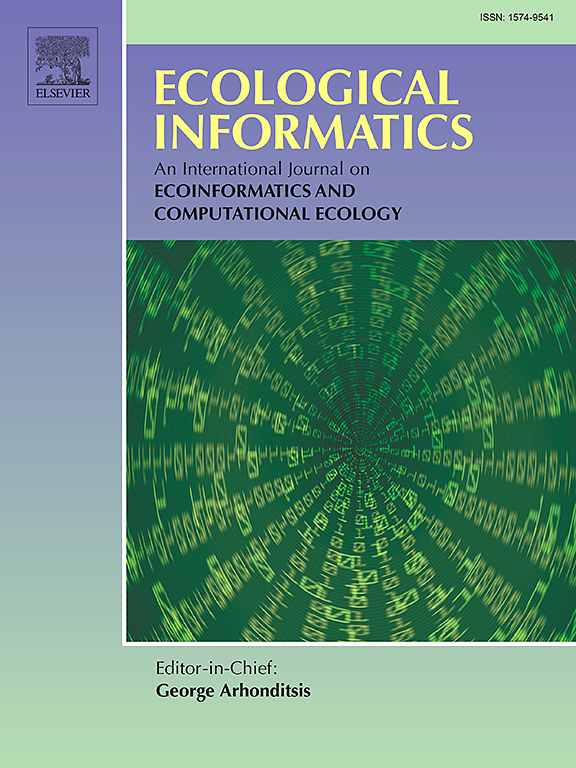共同推进无人机图像中动物检测的深度学习:成功、挑战和研究差距
IF 5.8
2区 环境科学与生态学
Q1 ECOLOGY
引用次数: 0
摘要
无人机已成为动物探测的有力工具,通过捕捉人类观察员通常无法到达或难以到达的区域的高分辨率实时图像,大大推进了野生动物的监测、保护和管理。然而,对无人机图像进行人工分析以检测动物既费力又费时。本综述全面概述了深度学习在利用无人机图像进行动物检测方面日益广泛的应用和前景。本文全面概述了深度学习在利用无人机图像进行动物检测方面日益广泛的应用和前景,探讨了深度学习在动物检测、定位、识别及其组合方面的成功应用。本文还讨论了这一领域的挑战、局限性和未来研究方向。本综述传达的一个关键信息是,需要有代表性的训练数据,涵盖目标动物可能出现的各种场景、图像标注困难以及不同研究中 DL 模型结果的可比性。许多研究都集中在单一物种、地点或具有高密度常见目标物种的图像上。对模型的评估可能会因使用单一测试集而产生偏差;许多研究缺乏评估模型效率、可行性和普适性的指标,而且关于无人机图像中不同动物检测任务的最佳训练图像数量和所需地面采样距离(GSD)还存在不确定性。通过提高图像中动物检测的准确性和效率,这项技术有助于了解和保护动物种群。为了扩大深度学习在不同物种、环境和空间尺度上的适用性,研究人员应创建标准化的基准数据集,并优先考虑开放合作和数据共享,这将有助于应对当前的挑战。本文章由计算机程序翻译,如有差异,请以英文原文为准。
Collectively advancing deep learning for animal detection in drone imagery: Successes, challenges, and research gaps
Drones have emerged as a powerful tool in animal detection, significantly advancing wildlife monitoring, conservation, and management by capturing high-resolution, real-time imagery over areas often inaccessible or challenging for human observers to reach. However, manual analysis of drone imagery for animal detection is labour-intensive and time-consuming. The application of deep learning methods, particularly convolutional neural networks, in automating animal detection from drone imagery has the potential to revolutionise wildlife monitoring, conservation, and management protocols.
This review provides a comprehensive overview of the increasing use and prospects of deep learning in animal detection using drone imagery. It explores successful applications of deep learning for animal detection, localisation, recognition, and their combinations. The paper also discusses the challenges, limitations, and future research directions of this field. A key message from this review is the need for representative training data covering the various scenarios in which target animals may appear, image annotation difficulties, and the comparability of DL model results across studies. Many studies have focused on single species, locations, or images with a high density of common target species. Assessments of models are potentially biased from using a single test set; many studies lack metrics to evaluate model efficiency, feasibility, and generalizability, and there are uncertainties regarding the optimal number of training images and required ground sample distance (GSD) for different animal detection tasks in drone imagery.
The potential applications of deep learning in wildlife monitoring, conservation, and ecological research using drone imagery are substantial. By enhancing the accuracy and efficiency of animal detection in imagery, this technology could contribute to the understanding and protecting animal populations. To expand the applicability of deep learning to diverse species, environments, and spatial scales, researchers should create standardised benchmark datasets and prioritise open collaboration and data sharing, which would aid in addressing the current challenges.
求助全文
通过发布文献求助,成功后即可免费获取论文全文。
去求助
来源期刊

Ecological Informatics
环境科学-生态学
CiteScore
8.30
自引率
11.80%
发文量
346
审稿时长
46 days
期刊介绍:
The journal Ecological Informatics is devoted to the publication of high quality, peer-reviewed articles on all aspects of computational ecology, data science and biogeography. The scope of the journal takes into account the data-intensive nature of ecology, the growing capacity of information technology to access, harness and leverage complex data as well as the critical need for informing sustainable management in view of global environmental and climate change.
The nature of the journal is interdisciplinary at the crossover between ecology and informatics. It focuses on novel concepts and techniques for image- and genome-based monitoring and interpretation, sensor- and multimedia-based data acquisition, internet-based data archiving and sharing, data assimilation, modelling and prediction of ecological data.
 求助内容:
求助内容: 应助结果提醒方式:
应助结果提醒方式:


